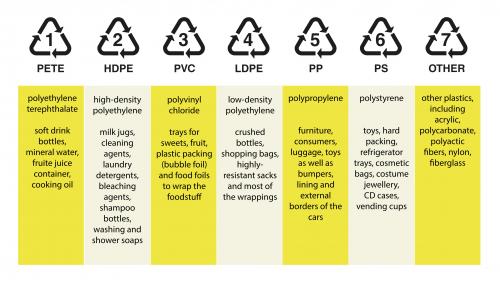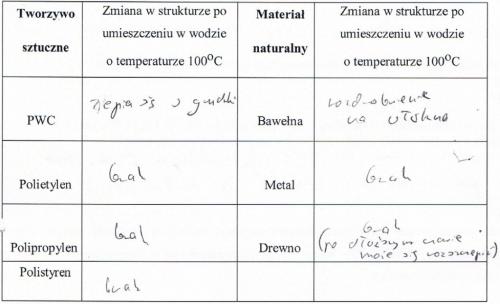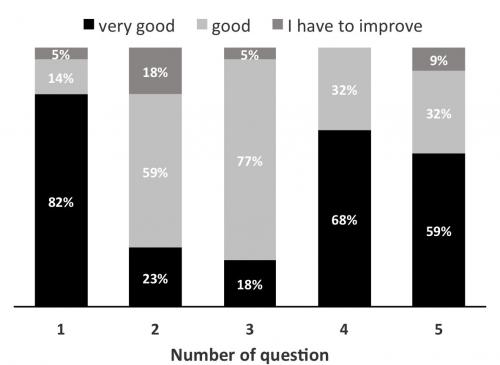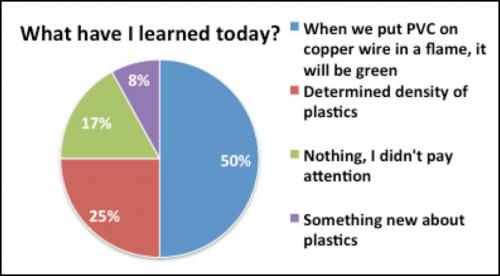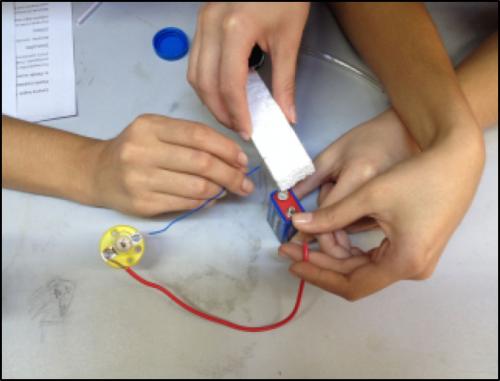The Polymers SAILS inquiry and assessment unit focuses on studying properties of plastic materials (density, thermal and electrical conductivity, combustibility) through experimentation. Students develop hypotheses about expected properties based on their previous knowledge and verify them subsequently by experimentation. This unit is recommended for implementation at upper second level and the unit activities are presented as a guided inquiry.
Activity A introduces the determination of density of plastic materials by comparing with water density, while Activity B looks at combustion properties of plastic materials. Further activities look at their thermal stability and thermal conductivity (Activity C) and electrical conductivity (Activity D).
This unit can be used for development of many inquiry skills, in particular developing hypotheses and planning investigations. In addition, students can develop their skills working collaboratively, and enhance their scientific reasoning and scientific literacy. The assessment methods described include teacher observation, use of student artefacts and self-assessment.
This unit was trialled by teachers in Ireland, Poland, Slovakia and Turkey – producing five case studies of implementation (four case studies with students aged 14-16 years and a Turkish case study with pre-service teachers). Working collaboratively and planning investigations were assessed in most case studies, while the assessment of developing hypotheses, forming coherent arguments and scientific reasoning is also reported. The assessment methods described include classroom dialogue, self-assessment and evaluation of students' worksheets.
- Determining density of plastic materials by comparing with water density
- Thermal stability and thermal conductivity of plastic materials
- Combustion of plastic materials
- Electrical conductivity of plastic materials
- Upper
- Planning investigations
- Developing hypotheses
- Forming coherent arguments
- Working collaboratively
- Scientific reasoning
- Scientific literacy
- Classroom dialogue
- Teacher observation
- Peer-assessment
- Self-assessment
- Worksheets
- Student devised materials
The teaching and learning activities described in the Polymers SAILS inquiry and assessment unit were developed by the FP7 ESTABLISH project (http://www.establish-fp7.eu/resources/units/plastic-and-plastic-waste), and adapted for use in the SAILS project. The unit is designed for implementation with students aged 14-17 years, and develops in four parts (activities A-D), in which students are introduced to properties of plastic. Due to its properties, plastic has a wide range of use in all spheres of human activities. In comparison to traditional materials such as metals, polymers have many advantages such as easy processing, low density and a convenient ratio of utility qualities and price. Students acquire knowledge of plastic from everyday life and they will deepen it in this unit. They will verify different properties of plastic by experiment.
In the unit activities, students have the opportunity to study various polymers, looking at their physical and chemical properties. Then, on the basis of acquired experience, students estimate their practical and industrial utilisation, considering both existing and potential applications. Students should think of polymers occurring in their surroundings and consider the reasons for application of the given polymer based on its properties, for example why PVC was used for a particular toy. Furthermore, they will analyse the properties of plastics using several tests (flame test, density) and propose the applications of polymers tested.
Some tools for formative assessment are provided in the unit, aimed at verifying the development of inquiry skills of developing hypotheses, planning investigations, forming coherent arguments and working collaboratively. Several assessment opportunities have been identified, and methods include self-assessment, peer-assessment and assessment by the teacher through observation, discussion or evaluation of written materials.
Below you can find the full inquiry and assessment unit for download, as well as an archive with classroom materials, including student worksheets and assessment tools for teachers to be used during the activities if available.
Unit booklet Classroom materials| Concept focus |
Determination of density of selected plastics
|
| Inquiry skills focus |
Planning investigations
Developing hypotheses
Working collaboratively
|
| Scientific reasoning |
Addressing problem through logic and use of evidence
Making comparisons
|
| Scientific literacy |
Explain phenomena scientifically
|
| Assessment methods |
Classroom dialogue
Teacher observation
Worksheets
|
| Concept focus |
Examine the properties of individual types of plastics during combustion
Prove the presence of chlorine in PVC by the flame test
|
| Inquiry skills focus |
Planning investigations
Developing hypotheses
|
| Scientific reasoning |
Addressing problem through logic and use of evidence
Making comparisons
|
| Scientific literacy |
Explain phenomena scientifically
|
| Assessment methods |
Classroom dialogue
Teacher observation
Worksheets
|
| Concept focus |
Explore the influence of heat on the behaviour of plastics
Comparison of the thermal conductivity of plastics and metals
|
| Inquiry skills focus |
Planning investigations
Developing hypotheses
Working collaboratively
|
| Scientific reasoning |
Addressing problem through logic and use of evidence
Making comparisons
|
| Scientific literacy |
Explain phenomena scientifically
|
| Assessment methods |
Classroom dialogue
Teacher observation
Worksheets
|
| Concept focus |
Investigate electrical conductivity of plastics
Compare electrical conductivity of plastics with that of other materials
Investigate static electricity
|
| Inquiry skills focus |
Planning investigations
Developing hypotheses
Working collaboratively
|
| Scientific reasoning |
Addressing problem through logic and use of evidence
Making comparisons
|
| Scientific literacy |
Explain phenomena scientifically
|
| Assessment methods |
Classroom dialogue
Teacher observation
Worksheets
Other assessment items
|
This unit was trialled in four countries, producing five case studies of its implementation – CS1 Ireland, CS2 Poland, CS3 Slovakia, CS4 Slovakia and CS5 Turkey. The activities were carried out with lower level students in four of the case studies (CS1-4), while CS5 Turkey details implementation with pre-service teachers (aged 20 years) who had limited experience of inquiry. The unit was implemented in full in CS2 Poland and CS5 Turkey, while CS1 Ireland omitted Activity D. In CS3 Slovakia implementation focused on Activity C and CS4 Slovakia trialled activities A and B.
Classes were of mixed gender, and students were aged 14 years in CS1 Ireland, CS3 Slovakia and CS4 Slovakia, and aged 16 in CS2 Poland. In CS4 Slovakia, the class was one that normally achieves lower grades. In all case studies, the students involved had little or limited experience of inquiry learning, with the exception of those in CS1 Ireland and CS5 Turkey.
The case studies identify the versatility of the unit in that it allowed teachers to focus on different concepts and inquiry skills to be developed and assessed. It can be used at different levels, as shown in the case studies where it was used with second level students and pre-service teachers. Finally, the case studies demonstrate a range of strategies and assessment data that can be collected to assess student inquiry development.
The teachers working in different contexts modified the implementation of the unit. However the use of a guided inquiry approach was predominate in each case study. There was some variation in the level of openness of the guided approaches used at various stages in the activities. For example in CS1 Ireland the students first engaged in an open inquiry investigation for Activity A, but activities B and C were implemented using a guided inquiry approach and worksheets were provided to aid in guiding the process. In all case studies examples of students being led by multiple teacher questions and completion of worksheets were documented. In all case studies, the lessons started with a teacher introduction that then moved on to discussing plastics and their everyday use. This was mostly followed by student discussion leading to teacher instigated guided inquiry investigations. In all case studies, the teachers used student worksheets from the units to help guide and record student work and thinking.
Within the five case studies, the teachers used a variety of formative and summative assessment strategies; these included teacher observation, teacher questioning, student self-assessment and analysis of student work. Teacher and student rubrics were used in many of the case studies to help the teacher to make judgements on student work and for the students to assess their own development. Whilst students gained experience of many inquiry skills not all of these were assessed. In some of the case studies the teachers chose to focus on specific skills to assess, for example in CS3 Slovakia the teacher solely assessed working collaboratively and in CS2 Poland the teacher focused on assessing working collaboratively and planning investigations (including data collection). The assessment was carried out at different levels in the various case studies. In some case studies the teacher assessed at a group level e.g. CS5 Turkey, and in others the assessment level related to the skill being assessed e.g. in CS1 Ireland, the teacher assessed working collaboratively at the group level and scientific literacy at an individual level. In assessing the skills the teachers used many rubrics and indeed adapted and developed new rubrics to assess the various skills. While they found the rubrics of useful, some of them found them challenging to implement.
Below you can find the full inquiry and assessment unit for download (excluding the case studies), as well as an archive containing all the case studies.
Unit booklet Case studies| Concept focus |
Classification of plastics
Properties of plastics (density, thermal stability, combustion)
|
| Activities implemented |
Determining density of plastic materials by comparing with water density
Combustion of plastic materials
Thermal stability and thermal conductivity of plastic materials
|
| Inquiry skills assessed |
Planning investigations
Developing hypotheses
Forming coherent arguments
Working collaboratively
|
| Scientific reasoning |
Problem-solving
|
| Scientific literacy |
Understand properties of plastics and how they are utilised in everyday life
|
| Assessment methods |
Classroom dialogue
Teacher observation
Peer-assessment
Self-assessment
Worksheets
|
| Level |
Lower
|
| Age |
14
|
| Prior experience with inquiry |
Very experienced
|
| Concept focus |
Properties of plastics (density, thermal stability, combustion)
|
| Activities implemented |
Determining density of plastic materials by comparing with water density
Combustion of plastic materials
Thermal stability and thermal conductivity of plastic materials
Electrical conductivity of plastic materials
|
| Inquiry skills assessed |
Planning investigations
Working collaboratively
|
| Assessment methods |
Classroom dialogue
Teacher observation
Self-assessment
Worksheets
|
| Level |
Lower
|
| Age |
16
|
| Prior experience with inquiry |
No experience
|
| Concept focus |
Properties of plastics (thermal stability and conductivity)
|
| Activities implemented |
Thermal stability and thermal conductivity of plastic materials
|
| Inquiry skills assessed |
Working collaboratively
|
| Assessment methods |
Classroom dialogue
Self-assessment
|
| Level |
Lower
|
| Age |
14-15
|
| Prior experience with inquiry |
No experience
|
| Concept focus |
Properties of plastics
Determination of density of plastics
Combustion of plastics – Beilstein’s test for halogens
|
| Activities implemented |
Determining density of plastic materials by comparing with water density
Combustion of plastic materials
|
| Inquiry skills assessed |
Forming coherent arguments
|
| Scientific reasoning |
Forming conclusions
|
| Scientific literacy |
Explain phenomena scientifically
Understanding properties of plastics and how they are utilised in everyday life
|
| Assessment methods |
Self-assessment
Worksheets
|
| Level |
Lower
|
| Age |
15
|
| Prior experience with inquiry |
No experience
|
| Concept focus |
Properties of plastics (density, thermal stability, combustion, electrical conductivity)
|
| Activities implemented |
Determining density of plastic materials by comparing with water density
Combustion of plastic materials
Thermal stability and thermal conductivity of plastic materials
Electrical conductivity of plastic materials
|
| Inquiry skills assessed |
Planning investigations
Developing hypotheses
Working collaboratively
|
| Scientific reasoning |
Recording data and observations
|
| Level |
Upper
|
| Age |
19-20
|
| Prior experience with inquiry |
Very experienced
|

